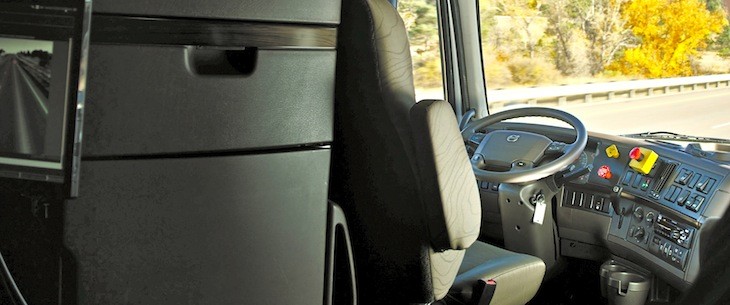J.B. Hunt exec wants lawmakers to consider big rigs in autonomous legislation, driver turnover hits 95%
by December 7, 2017 4:30 pm 806 views

A J.B. Hunt executive said in a congressional roundtable hosted by a U.S. House of Representatives subcommittee that autonomous vehicle legislation under consideration by Congress should address commercial and passenger vehicles as truck driver turnover rose to its highest level since late 2015.
On Thursday (Dec. 7), Greer Woodruff, senior vice president of safety, security and driver personnel for J.B. Hunt, spoke to the House Transportation and Infrastructure Committee’s Subcommittee on Highways and Transit Roundtable: Emerging Technologies in the Trucking Industry.
Woodruff, speaking on behalf of the Lowell-based carrier and trade organization American Trucking Associations, said J.B. Hunt was one of many ATA members who were “early adopters of emerging safety technologies,” and these technologies, including driver assist and advanced driver assist, are the foundation for level four and level five autonomous vehicles. Level five autonomous vehicles do not require a driver to operate the vehicle.
Each year, the trucking industry spends more than $9 billion on safety, including technology improvements, to help drivers and passengers of all vehicles safety reach their destinations, he said. Safety technologies offer “immediate safety benefits as they are adopted and some are mature enough and have proven safety benefits that warrants serious consideration by (National Highway Traffic Safety Administration) that they become standard specifications on all vehicles. While we support pursuit of autonomous vehicles, we recognize that commercial drivers are an indispensable asset to the safe operation of commercial motor vehicles.”
Woodruff, who serves on the Federal Motor Carrier Safety Administration’s Safety Advisory Committee, said the autonomous vehicle legislation should address passenger and commercial vehicles “to ensure state and federal laws do not conflict or impede interstate commerce.” Also, this would allow for “the ability to receive exemptions from (existing) federal regulations so that new technologies can be developed and tested.”
Woodruff also mentioned J.B. Hunt’s recent announcement that it reserved “multiple Tesla Semi tractors and plans to deploy them in intermodal and dedicated contract services divisions to support operations on the West Coast. These electric tractors will have advanced driver safety assist systems.”
Electric vehicle battery costs per kilowatt hour have fallen 65% since 2010, and in the past year, the costs have declined 35%, he said. This, along with the expected savings in maintenance, should offset total cost of ownership for the electric big rigs to “rival” the cost for diesel engine commercial vehicles.
The Tesla big rigs have an existing range of 300 miles. But the range is expected to be extended to 500 miles, and the batteries could be charged to 80% capacity in 30 minutes.
“Based on these advancements, ATA and J.B. Hunt support confirmed testing, deployment and adoption of advanced driver assist systems and electric vehicles,” Woodruff told legislators.
On Wednesday (Dec. 6), Chris Spear, president and CEO of the ATA, said the existing autonomous vehicle legislation before Congress that would establish regulations for passenger vehicles but not commercial vehicles isn’t reflective of the “driving landscape” and would “fall short on safety.” Spear spoke as one of several panelists in a discussion on infrastructure hosted by CQ Roll Call at the Newseum.
In September, the House passed the legislation for passenger vehicles, and in October, a Senate committee approved a version of the legislation also focused on passenger vehicles. The bill stalled in the Senate after disagreements over consumer protections and safety parameters, according to Transport Topics.
DRIVER TURNOVER
The truck driver turnover rate for large trucking fleets increased five percentage points to 95% in the third quarter, according to ATA Chief Economist Bob Costello.
“Since bottoming out at the end of 2016, the turnover rate at large trucking fleets has steadily risen — a function of an improving economy, rising demand for freight transportation and fierce competition for drivers,” he said. “The tightening of the driver market has raised fears about the driver shortage, which will hit an all-time high this year.”
The turnover rate for small trucking fleets declined one point to 84% in the third quarter, two points higher than the same period in 2016. Small trucking fleets are those with less than $30 million in annual revenue. The rate for less-than-truckload fleets declined two points to 7% in the quarter, the lowest rate since the second quarter of 2016.
“Fleets continue to tell us that competition for good, safe and experienced drivers is fierce, pushing wages higher in hopes of attracting the best talent,” Costello said. “However, unless steps are taken to make it easier for individuals to pursue careers in trucking, demand for drivers will continue to outstrip supply — eventually even leading to supply chain disruptions.”
The shortage of truck drivers is expected to rise to more than 50,000 by the end of the year, according to the ATA. By 2024, the shortage was projected to jump to 174,000. Recently, the ATA began a workforce development effort with a focus on recruiting and retention strategies for the trucking industry.
